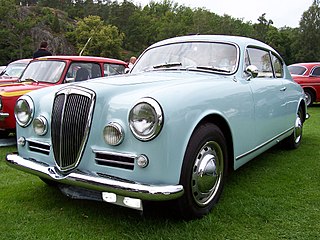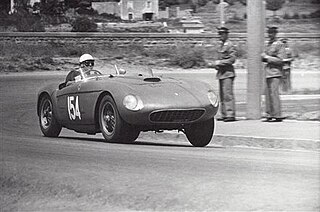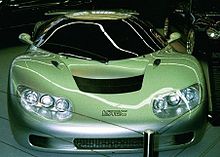
A V12 engine is a twelve-cylinder piston engine where two banks of six cylinders are arranged in a V configuration around a common crankshaft. V12 engines are more common than V10 engines. However, they are less common than V8 engines.

Touring car racing is a motorsport road racing competition with heavily modified road-going cars. It has both similarities to and significant differences from stock car racing, which is popular in the United States.
Power-to-weight ratio is a calculation commonly applied to engines and mobile power sources to enable the comparison of one unit or design to another. Power-to-weight ratio is a measurement of actual performance of any engine or power source. It is also used as a measurement of performance of a vehicle as a whole, with the engine's power output being divided by the weight of the vehicle, to give a metric that is independent of the vehicle's size. Power-to-weight is often quoted by manufacturers at the peak value, but the actual value may vary in use and variations will affect performance.

A V10 engine is a ten-cylinder piston engine where two banks of five cylinders are arranged in a V configuration around a common crankshaft. V10 engines are much less common than V8 and V12 engines. Several V10 diesel engines have been produced since 1965, and V10 petrol engines for road cars were first produced in 1991 with the release of the Dodge Viper.

The Mercedes-Benz SLR McLaren is a grand tourer jointly developed by German automotive manufacturer Mercedes-Benz and British automobile manufacturer McLaren Automotive and sold from 2003 to 2009. When the car was developed, Mercedes-Benz owned 40 percent of the McLaren Group and the car was produced in conjunction between the two companies. SLR is an abbreviation for "Sport Leicht Rennsport", a homage to the Mercedes-Benz 300 SLR which served as the car's inspiration. The car was offered in coupé, roadster and speedster bodystyles with the latter being a limited edition model.

The Mercedes-Benz 300 SL is a two-seat sports car which was produced by Mercedes-Benz as a gullwinged coupe (1954–1957) and roadster (1957–1963). It was based on the company's 1952 racer, the W194, with mechanical direct fuel injection which boosted power almost 50 percent in its three-liter overhead camshaft straight-six engine. Capable of reaching a top speed of up to 263 km/h (163 mph), it was a sports car racing champion and the fastest production car of its time.

The Mercedes-Benz W201 was the internal designation for the Mercedes 190 series sedans, a range of front-engine, rear drive, five passenger, four-door sedans manufactured over a single generation, from 1982 to 1993 as the company's first compact class automobile.

A grand tourer (GT) is a type of car that is designed for high speed and long-distance driving, due to a combination of performance and luxury attributes. The most common format is a front-engine, rear-wheel-drive two-door coupé with either a two-seat or a 2+2 arrangement. Grand tourers are most often the coupé derivative of luxury saloons or sedans.
Mercedes-AMG GmbH, commonly known as AMG, is the high-performance subsidiary of Mercedes-Benz AG. AMG independently hires engineers and contracts with manufacturers to customize Mercedes-Benz AMG vehicles. The company has its headquarters in Affalterbach, Baden-Württemberg, Germany.
Isdera AG or Ingenieurbüro für Styling, Design und Racing is a privately run German specialty automaker and design service provider based in Saarwellingen, with a design studio in Munich and a design subsidiary in Shanghai, China. The company was founded and formerly based in Leonberg, Germany. Each high-performance sports car is hand-built by a small team of craftsmen, and the only way to purchase a brand new Isdera was to call the CEO directly. Each vehicle is custom built for its original buyer, and a waiting period of twelve months is to be expected.

The Sauber C9 is a Group C prototype race car introduced in 1987 as a continuation of the partnership between Sauber as a constructor and Mercedes-Benz as an engine builder for the World Sportscar Championship. The C9 replaced the Sauber C8.

The Ferrari Monza is one of a series of cars built by Ferrari. In the early 1950s, Ferrari shifted from using the compact Gioacchino Colombo-designed V12 engine in its smallest class of sports racers to a line of four-cylinder engines designed by Aurelio Lampredi. Inspired by the success of the light and reliable 2.5 L 553 F1 car, the four-cylinder sports racers competed successfully through the late 1950s, culminating with the famed 500 Mondial and 750 Monza.

The Sauber SHS C6 was a Group C prototype racing car built by Swiss manufacturer Sauber and engineering firm Seger & Hoffman, intended for competition in the World Endurance Championship and Deutsche Rennsport Meisterschaft series. Seger & Hoffman left the project later in 1982, leaving the car completely under Sauber's control.

The Mercedes-Benz W194 is an endurance racer produced by Mercedes-Benz for the 1952 Sportscar racing season, its first after World War II.

The Ferrari 250 Monza was a sports racing car produced by Ferrari in 1954. It was a combination of a stretched chassis and body from the line of inline-four-engined racers with an ubiquitous 3.0-litre Colombo V12 engine.
The Lotec 681 was a sports prototype racing car, built by Lotec in 1981. Fitted with a BMW M88 straight-six engine, the car had a reasonably successful, albeit very brief, career before it was replaced by the Lotec M1C in 1982. One car was built.

The March 86G was a Group C and IMSA GTP sports racing car built by March Engineering. Built as simply a chassis with no engine, it was branded as one of three cars, the BMW GTP, the Buick Hawk or the Nissan R86V depending on which engine was placed in the chassis and which team was running it. There were a number of subtle bodywork changes to reflect the manufacturer which ran the car.
Mercedes-Benz made a series of pre-war supercharged Grand Prix racing engines for their Silver Arrow race cars; between 1934 and 1939. They made two supercharged inline-8 engines; the M25 and M125, and one V12 with two generations; the M154 / M163.

The Mercedes-Benz 500I engine is a highly powerful, turbocharged, 3.4-liter, Indy car racing V-8 engine, designed, developed, and built by Ilmor, in partnership with Mercedes-Benz, specifically to compete in the 1994 Indianapolis 500.















